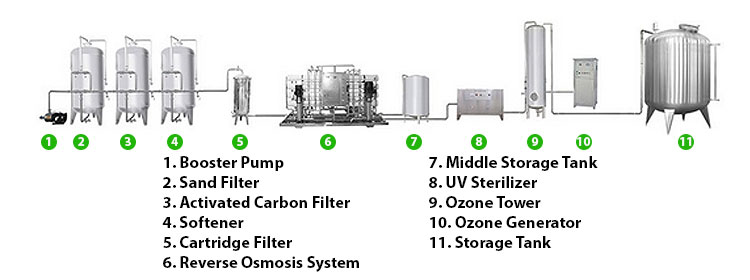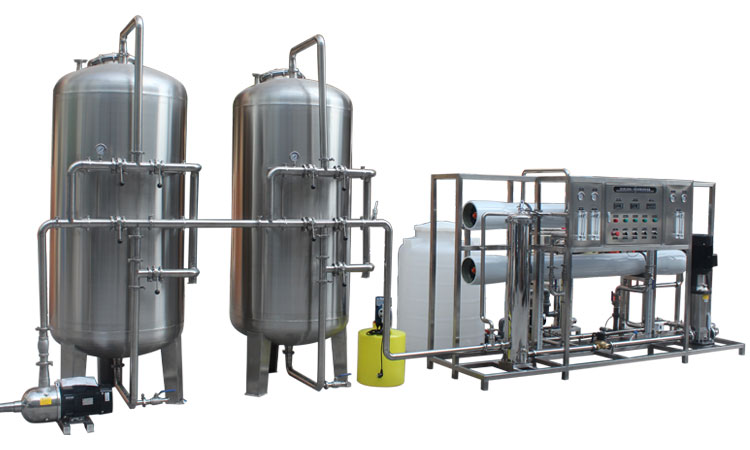In what cases should a reverse osmosis water purifier be used?
As a highly efficient water treatment device, a reverse osmosis (RO) water purifier can effectively remove pollutants such as dissolved salts, heavy metals, bacteria, viruses, etc. in water, providing extremely pure drinking water. However, a reverse osmosis water purifier is not suitable for all water quality environments or needs.
So, in what cases should a reverse osmosis water purifier be used? This article will explore this issue in detail to help readers understand the best application scenarios of reverse osmosis technology.

What is the basic principle of a reverse osmosis water purifier?
Before discussing the application scenarios of a reverse osmosis water purifier, it is necessary to understand its basic working principle. Reverse osmosis technology uses a semi-permeable membrane to apply high pressure to allow water molecules to pass through the membrane, while dissolved impurities (such as salts, heavy metals, bacteria, viruses, etc.) are retained on the other side of the membrane, thereby achieving water purification.
The pore size of the reverse osmosis membrane is very small, usually only about 0.0001 microns, which enables it to effectively filter out most dissolved pollutants. This sophisticated filtration mechanism enables reverse osmosis water purifiers to produce extremely pure water, often referred to as "pure water".
In what cases should reverse osmosis water purifiers be used?
Reverse osmosis water purifiers are widely used, especially for water treatment needs in the following cases:
1. High-salinity water quality
If the salinity in the drinking water source is high, such as salt water or groundwater in some areas, the use of reverse osmosis water purifiers is essential. RO technology can effectively remove dissolved salts in water and convert high-salinity water into low-salinity drinkable water.
Typical cases:
● Drinking water purification in coastal areas: Groundwater or freshwater resources in coastal areas are often affected by seawater intrusion, resulting in high salinity in the water and unsuitable for direct drinking. Reverse osmosis water purifiers can effectively remove salt from these waters and provide safe drinking water.
● Bitter and salty water treatment: In some inland areas, groundwater may contain high concentrations of salts and minerals due to geological reasons, resulting in a bitter taste in the water. In this case, reverse osmosis water purifiers can significantly improve the water quality and remove the bitter and salty taste.
2. Hard water treatment
Hard water contains high concentrations of calcium and magnesium ions, which can cause scale formation and affect the life of water pipes, water heaters and other household appliances. In addition, hard water can also affect the taste of drinking water and even have adverse effects on the health of some people. Reverse osmosis water purifiers can effectively remove hardness ions in water and provide softened water.
Typical cases:
● Softening of household drinking water: In areas with high water hardness, reverse osmosis water purifiers can provide softened drinking water for households, which not only improves water quality but also protects household appliances.
● Industrial applications: In some industrial processes, hard water may cause equipment scaling, affecting production efficiency and product quality. Reverse osmosis systems can remove hardness in industrial water treatment, protect equipment and improve product quality.
3. Heavy metals in water
Heavy metals such as lead, mercury, cadmium and arsenic are seriously toxic to the human body. Even at low concentrations, these metals may cause irreversible damage to health through long-term accumulation. Reverse osmosis technology can remove heavy metals in water and provide safer drinking water.
Typical cases:
● Industrially polluted water sources: In areas with severe industrial pollution, groundwater may be contaminated by heavy metals. Reverse osmosis water purifiers are particularly important in this case, and can filter out almost all heavy metals to ensure the safety of drinking water.
● Old pipe water supply system: When using old lead pipes or other water supply systems containing heavy metals, drinking water may contain excessive heavy metals. Reverse osmosis water purifiers can effectively remove these heavy metals to ensure water quality safety.

4. Microbial contamination
Microbial contamination in drinking water, including bacteria, viruses and parasites, may cause a variety of waterborne diseases. Reverse osmosis membranes can effectively intercept most microorganisms, especially when the water source is unstable or contaminated, providing additional safety for drinking water.
Typical cases:
● Drinking water purification in rural or remote areas: In some rural or remote areas that lack centralized water supply facilities, natural water sources such as well water and river water may be contaminated by microorganisms. Reverse osmosis water purifiers can provide safe and reliable drinking water for these areas.
● Emergency disaster relief scenarios: In natural disasters or public health emergencies, the water supply system may be damaged or polluted. The reverse osmosis system can be used as an emergency water purification device to ensure the safety of drinking water.
5. Volatile organic compounds (VOCs) in the water
Volatile organic compounds (VOCs) include a variety of chemicals, such as benzene, trichloroethylene, etc., which may produce odors and odors in water and are potentially harmful to health. Reverse osmosis technology combined with activated carbon pretreatment can effectively remove VOCs from water.
Typical cases:
● Drinking water purification near chemical plants: Wastewater discharged from chemical plants may cause excessive VOCs in nearby groundwater or surface water. Reverse osmosis water purifiers can significantly improve water quality safety in this case.
● Water odor treatment: In some areas, water may have an unpleasant odor due to the presence of VOCs. The reverse osmosis system improves the taste and safety of water by effectively removing these substances.
6. High-standard drinking water requirements in households or commercial settings
Some households or commercial settings have extremely high requirements for the purity of drinking water, such as medical institutions, laboratories, and the catering industry. Reverse osmosis water purifiers can provide high-quality drinking water that is close to pure water to meet the special needs of these occasions.
Typical cases:
● Medical institutions: Hospitals or clinics require high-purity water for cleaning equipment, preparing medicines, or directly for patients to drink. Reverse osmosis systems can provide sterile, low-mineral water that meets medical standards.
● Laboratories: Laboratories often need to use pure water when conducting chemical analysis, biological research, etc. to avoid impurities in the water interfering with experimental results. Reverse osmosis systems can provide the required high-purity water source for laboratories.
● High-end catering industry: In order to provide better quality drinks and food, some high-end catering industries also use reverse osmosis water purifiers to ensure that the water quality does not affect the taste of food and drinks.
7. Unstable or unreliable local water supply quality
In some areas, the water quality of tap water supply may be unstable due to aging pipes, pollution accidents, or insufficient water treatment facilities, posing potential health risks. Reverse osmosis water purifiers can serve as an extra layer of protection for home or commercial users to ensure water safety.
Typical cases:
● Urban water supply in developing countries: In some developing countries, urban water supply systems may not be able to guarantee water safety, especially during rainy seasons or floods, when water quality may be contaminated. Reverse osmosis water purifiers can effectively ensure the safety of household drinking water in this case.
● Backup measures during water supply interruptions: During water supply interruptions or substandard water quality, reverse osmosis systems can be used as backup water purification methods to provide safe drinking water for homes or commercial places.

What are the limitations of reverse osmosis water purifiers?
Although reverse osmosis water purifiers have excellent water purification capabilities, they also have some limitations that users need to fully consider when deciding whether to install a reverse osmosis system.
1. Waste of water
During the operation of the reverse osmosis system, a certain amount of wastewater is generated, usually 3 to 4 liters of wastewater for every liter of pure water produced. This may not be suitable for areas with limited water resources.
2. High equipment cost
The initial investment and maintenance costs of reverse osmosis water purifiers are relatively high. The price of the equipment itself is usually not cheap, and the installation costs and the cost of regular replacement of the filter membrane make the overall cost high. Although using a reverse osmosis system can save bottled water expenses in the long run, the initial investment is still a factor that needs to be considered.
3. Regular maintenance is required
The filter membrane and other components of the reverse osmosis system need to be replaced and maintained regularly to maintain their optimal performance. The service life of the filter membrane is usually around 2 to 3 years, while the replacement cycle of the pre-filter and post-filter may be shorter. The maintenance and replacement costs plus the complexity of operation make maintenance a challenge that users must face.
4. Removal of beneficial minerals
While the reverse osmosis system removes harmful substances, it also removes some minerals in the water that are beneficial to the human body, such as calcium and magnesium. This may result in a lower mineral content in drinking water, which affects the taste and nutritional value of the water. In this case, the user may need additional mineral supplements or choose a reverse osmosis system with a mineral supplement function.

Recommendations for the use of reverse osmosis systems
Before deciding to install a reverse osmosis system, you first need to evaluate the quality of the water source. For water sources with high salinity, high hardness, heavy metals or microbial contamination, reverse osmosis systems are a very suitable choice. However, for water with good quality or only slight contamination, other more cost-effective filtration solutions may need to be considered. At the same time, choose the appropriate reverse osmosis system according to the water needs of the home or business. There are reverse osmosis systems with different specifications and functions on the market, including basic, mid-to-high-end and systems with mineral addition functions. Users should choose the most suitable equipment according to actual needs.
In order to maintain the optimal performance of the reverse osmosis system, users need to regularly perform equipment maintenance and filter membrane replacement. Regular inspection and maintenance can not only extend the service life of the equipment, but also ensure the stability of the effluent water quality. In some cases, combining other filtration technologies (such as activated carbon filtration, UV sterilization, etc.) can further improve water quality. For example, the use of activated carbon filters with good organic matter removal effects in combination with reverse osmosis systems can improve the overall water treatment effect.
Conclusion
As an efficient water treatment equipment, reverse osmosis water purifiers have shown their unique advantages in treating water sources with high salinity, high hardness, heavy metals and microbial contamination. Despite its limitations, such as water waste, equipment cost and maintenance requirements, its excellent water purification ability makes it an ideal choice in specific application scenarios.
When deciding whether to use a reverse osmosis system, users need to consider water quality, equipment costs and maintenance requirements, and choose the most suitable water treatment solution to ensure the safety and health of drinking water.




